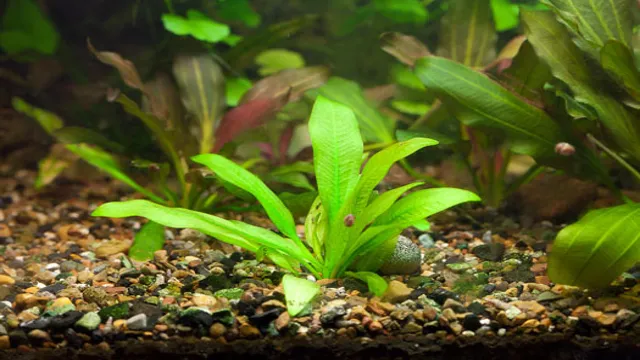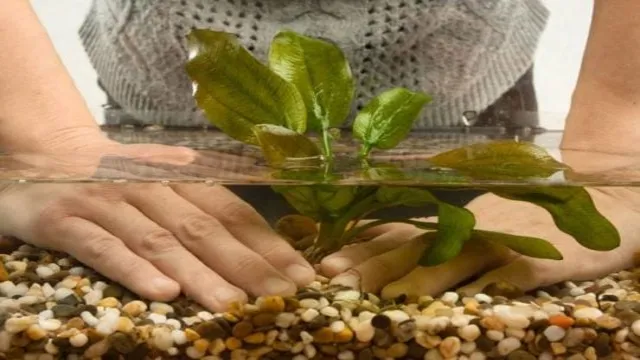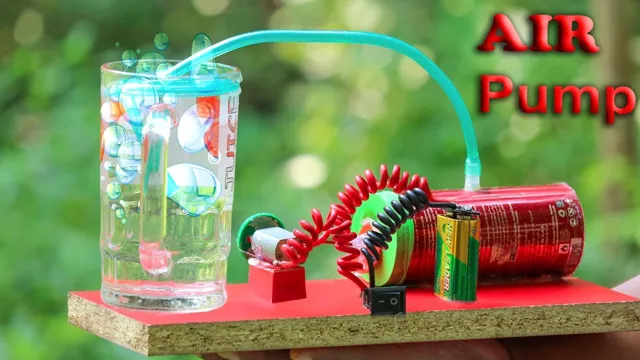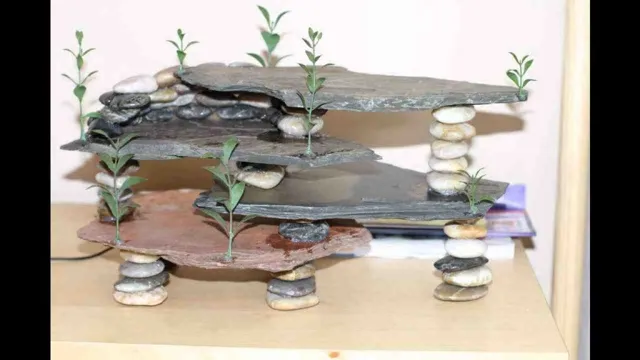How to Prepare Aquarium Plants: Tips and Techniques for Optimal Growth

Are you interested in creating a beautiful and healthy aquarium for your aquatic friends? One of the key elements in achieving a successful aquarium is the proper preparation of aquarium plants. When done correctly, aquarium plants not only add aesthetic value to your tank, but they can also provide natural filtration, oxygenation, and hiding places for fish. However, preparing aquarium plants isn’t as simple as placing them in the tank and hoping for the best.
In this guide, we’ll cover the necessary steps to ensure your aquarium plants are ready to thrive in their new environment. From cleaning and trimming to selecting the right substrate and nutrients, we’ve got you covered. Keep reading to learn everything you need to know about preparing aquarium plants for your underwater paradise.
Why it’s important to prepare plants
If you’re looking to set up an aquarium, taking the time to prepare your plants can make all the difference in the world. Not only will it help your plants thrive, but it can also make your tank healthier for your fish. There are a few things you can do to make sure your aquarium plants are ready to go.
First, make sure you clean them thoroughly. Dead leaves and debris can cause problems in your tank, so trim any dead parts and clean off any dirt or algae on the leaves. You can use a solution of water and vinegar or hydrogen peroxide to disinfect them.
Next, make sure you plant them correctly. Different plants have different needs, so research each one thoroughly before planting. Finally, be sure to provide the right lighting and nutrients for each plant.
Plants are just like any other living thing, they need the right conditions to thrive. With a little preparation, your aquarium plants will be healthy and beautiful for years to come.
Establishing a healthy environment
Preparing plants is a crucial step in establishing a healthy indoor environment. Why? Simply put, plants need to be taken care of just like any other living thing. Preparing them means ensuring that they have the necessary nutrients, light, and water they need to survive and thrive.
This is especially important when you’re bringing them indoors, where they may not have access to natural sunlight or fresh air. By taking the time to prepare your plants, you can help them acclimate to their new environment and reduce the risk of stress or disease. So, whether you’re starting a new garden or bringing home a few plants from the store, make sure to give them the care they need to grow healthy and strong.

Preventing disease and pests
Preventing disease and pests is crucial for keeping your plants healthy, and it all starts with proper preparation. Just like we take preventative measures to maintain our own health, such as washing our hands and getting enough sleep, plants require a similar level of care. By preparing your plants before they even hit the ground, you can minimize the risk of damage from pests and disease.
One way to do this is by making sure the soil is healthy and nutrient-rich. This can be achieved by adding organic matter, such as compost or manure, to the soil. Additionally, you can select disease-resistant plants, use natural pest repellents, and avoid overwatering your plants.
These steps may seem small, but they can make a big difference in the long run. With a little preparation and care, you can help your plants thrive and avoid the devastation caused by disease and pests.
Steps to preparing aquarium plants
Preparing aquarium plants is an important step in ensuring a healthy and vibrant aquatic environment for your fish. The first step in preparing aquarium plants is to choose the right plant. Some plants require specific water conditions or lighting, so it’s important to do some research before making a purchase. (See Also: How to Make Your Aquarium Water Clear: 5 Effective Ways to Achieve Crystal Clear Water)
Once you have the right plant, it’s time to clean it. This involves removing any dead leaves or debris, as well as rinsing off any dirt or pests that may be attached to the plant. It’s also a good idea to trim the roots and remove any excess weight, as this will help the plant adapt to its new environment.
Finally, before adding the plant to your tank, make sure to acclimate it slowly to your water conditions, as sudden changes in temperature or pH can shock the plant and cause it to die. By taking these steps, you can help ensure a healthy and thriving aquatic environment for your fish!
Acquiring and Maintaining Healthy Plants
Preparing aquarium plants is an important step in creating a healthy and beautiful underwater environment. To start, make sure you have a clean tank with appropriate lighting and a good substrate. Next, carefully choose your plants based on their size, light and nutrient requirements, and compatibility with other species.
Before planting, rinse the plant thoroughly to remove any dirt or debris and trim any damaged or dead leaves. Gently insert the roots into the substrate, taking care not to damage them. Finally, provide sufficient nutrients and carbon dioxide to help the plants grow and thrive.
Adding a liquid fertilizer or CO2 injection system can go a long way in ensuring your plants look their best. Remember, healthy plants lead to a healthy aquarium ecosystem!
Cleaning and Preparing Substrate
Preparing aquarium plants is an essential task that must not be overlooked. When setting up your aquarium, make sure to clean and prepare the substrate before adding your plants. This involves removing any debris, dirt, and unwanted sediments that might clog the substrate over time.
You can use a gravel vacuum or siphon to accomplish this task effectively. Also, be sure to rinse the substrate thoroughly to remove any dust or other particles that might cloud the water. Once you have cleaned the substrate, you can begin planting your aquarium plants.
Keep in mind that different plant species may require different substrate types, such as sand or gravel. Therefore, make sure to research the specific needs of each plant before planting them in your aquarium. Properly preparing your aquarium plants will ensure that they thrive and provide a beautiful, natural environment for your fish to enjoy.
Planting Techniques
Planting aquarium plants can be an enjoyable and rewarding experience, but it’s essential to do it right to ensure that your plants thrive and grow. The first step is to clean your aquarium tank thoroughly and remove any debris. Once you are done, it is recommended to add a substrate of choice, which can be sand or aquarium gravel.
This will provide nutrients and support for the plants to grow. Next, you need to select the plants you want to add to your aquarium. Ensure that you choose plants that will thrive in the specific water conditions in your aquarium.
To plant the plants, make a small hole in the substrate and insert the plant. Cover the roots with substrate, but make sure the crown of the plant remains visible. It is crucial to take care when planting, avoid damaging the plant and ensuring the right placement.
Lastly, fill your tank with water and ensure that your plants get the right amount of light and nutrients they need to grow. The right planting technique will ensure a vibrant and healthy aquarium. (See Also: How to Sponge Filter Aquarium: A Comprehensive Guide)
Caring for your prepared plants
Knowing how to properly prepare aquarium plants is essential for their health and longevity in your fish tank. Before adding them to your aquarium, make sure to rinse them thoroughly to remove any debris or unwanted hitchhiking organisms. While preparing them, keep in mind the specific needs of the plant in terms of lighting, substrate, and water parameters.
Some plants may require a nutrient-rich substrate or CO2 supplementation, while others do better in low light and may not need additional nutrients. It’s important to research each plant’s individual needs beforehand to ensure their proper care. Additionally, regularly pruning and removing dead or damaged leaves will help maintain the overall health and appearance of your plants.
By taking these steps, you can create a thriving and beautiful aquatic environment for your fish and plants alike.
Maintaining Water Quality
Maintaining water quality is crucial for the long-term health of your aquatic plants. It’s important to regularly test the water in your aquarium or pond and keep an eye out for any changes in color or clarity. One way to maintain water quality is to use a filter to remove any debris and toxins from the water.
You can also add live plants to help absorb excess nutrients and improve oxygen levels. Additionally, performing partial water changes every one to two weeks can help dilute any harmful substances in the water. By taking these steps, you can ensure that your prepared plants are thriving in a clean and healthy environment.
Providing appropriate lighting and nutrients
To care for your prepared plants, providing appropriate lighting and nutrients is crucial. Different plants have different requirements when it comes to lighting, so make sure to research the specific needs of your plants. Some may require direct sunlight, while others may prefer indirect or filtered light.
You can also use artificial grow lights if natural sunlight is not enough. When it comes to nutrients, you can use organic fertilizers or create your compost. Remember not to over-fertilize your plants, as this can lead to nutrient burn or other issues.
It’s also crucial to make sure your plants have proper drainage and aren’t sitting in stagnant water. By providing your prepared plants with the right lighting, nutrients, and care, you can help them thrive and flourish in their new environment.
In conclusion
In conclusion, preparing aquarium plants is a crucial step in ensuring a healthy and thriving aquatic environment for your fish. Following the proper steps, including washing and trimming the plants before planting them in the substrate, is essential for plant growth. Understanding the various types of plants and their lighting and nutrient requirements is also crucial to their success.
Keep in mind that regular maintenance, including pruning and removing dead leaves, is necessary to prevent the plants from decaying and negatively impacting the water quality. By taking the time to properly prepare and maintain aquarium plants, you can create a beautiful and healthy underwater ecosystem for your aquatic pets to enjoy. So, don’t forget to put in the effort and care that your aquarium plants deserve, and you’ll be rewarded with a stunning and thriving aquatic environment.
Conclusion
In conclusion, preparing aquarium plants may seem like a daunting task, but with a little bit of research and effort, you can have a thriving aquatic garden in no time. Remember to choose the right plants for your tank, provide proper lighting and nutrient levels, and maintain a clean and healthy environment for your underwater friends. Your hard work will pay off with a beautiful and colorful addition to your home or office that will be the envy of all your fish-loving friends. (See Also: How to Make a Sweet Potato Holder in Aquarium Tank for Your Fish)
So dive in and get your hands wet – your aquatic plants will thank you for it!”
FAQs
What are the essential things to consider before preparing an aquarium for plants?
You should consider things like lighting, water quality, substrate, and the type of plants you want to grow.
How should I clean and prepare my aquarium before adding plants?
Thoroughly clean the aquarium and avoid using soap or other cleaners that may harm your plants. Additionally, rinse the substrate and decorations used in the aquarium.
Which plants are best suited for aquarium environments?
You can opt for plants like Java moss, Anubias, Amazon sword, Ludwigia, or Cryptocoryne, as these are easy to grow and maintain in aquariums.
How often should I fertilize my aquarium plants?
It depends on the type of plants you have and the fertilizers you use. In general, you should fertilize your plants once a week to keep them healthy and vibrant.
How much light do aquarium plants need?
It is recommended to provide 8 to 10 hours of light per day for most aquarium plants. However, the amount of light required can vary depending on the plant species.
Can plants help to improve the quality of aquarium water?
Yes, aquarium plants can help to filter and purify the water by absorbing excess nutrients like nitrogen and phosphorous from the water.
How should I prune my aquarium plants?
You should trim any dead or yellow leaves regularly, remove any dead or damaged plant parts, and trim the plants to prevent them from overgrowing.






